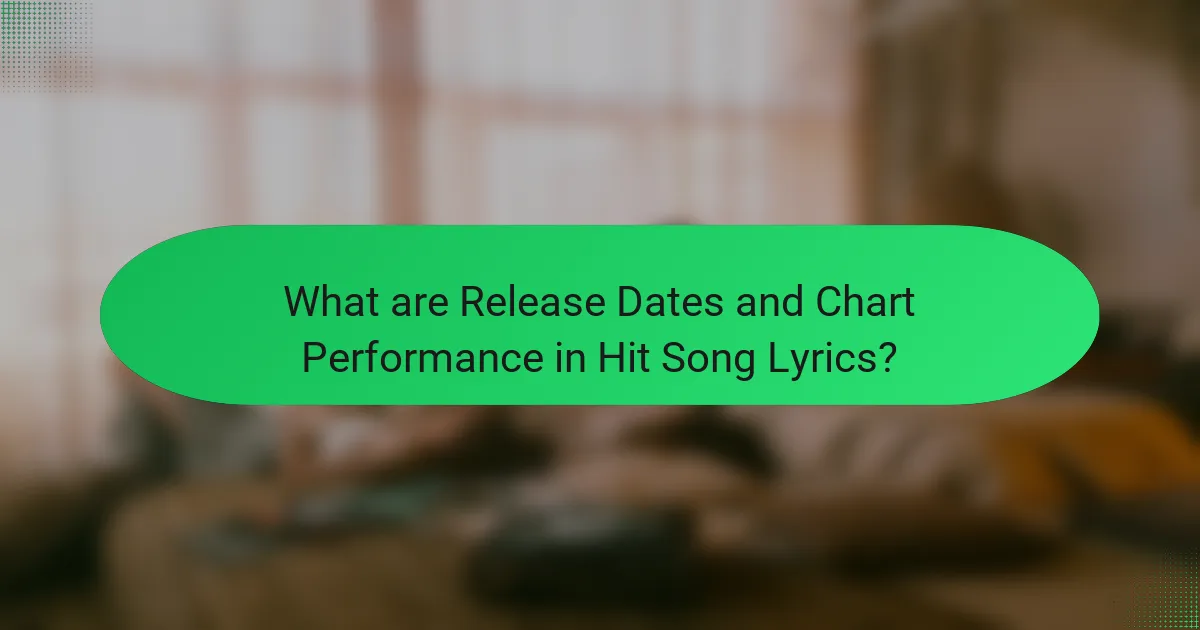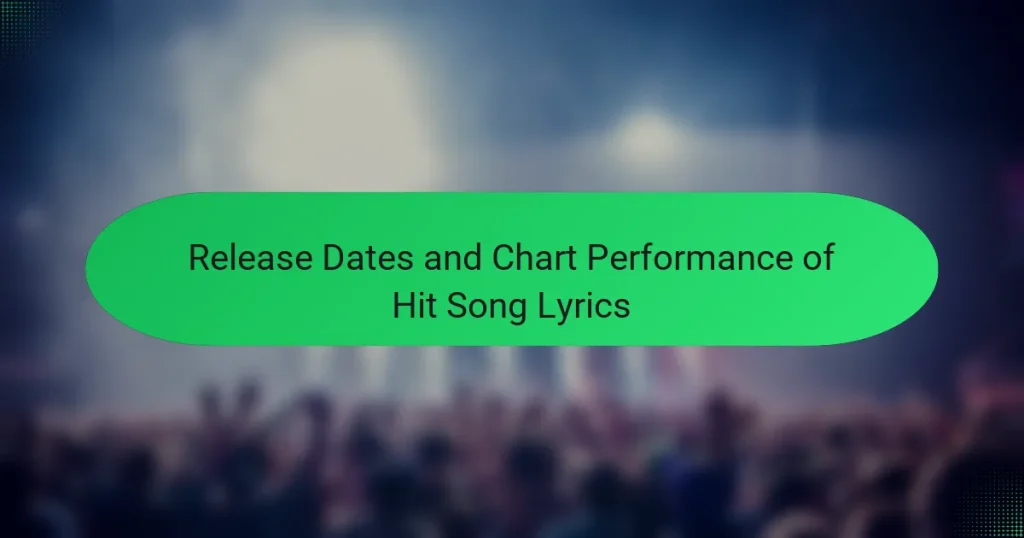Release dates are the specific days when songs are made available to the public, and chart performance measures how well these songs rank on music charts like the Billboard Hot 100. The article explores the relationship between strategic release timing and a song’s commercial success, highlighting factors such as consumer behavior, seasonal trends, and peak listening times. It examines notable examples, including BTS’s “Butter” and The Weeknd’s “Blinding Lights,” to illustrate how release dates impact chart positions and longevity. Additionally, the article discusses unique attributes of hit songs, including peak position, chart duration, and genre influence, providing insights into their cultural significance and market performance.

What are Release Dates and Chart Performance in Hit Song Lyrics?
Release dates refer to the specific days when songs are officially made available to the public. Chart performance indicates how well a song performs on music charts after its release. These metrics are crucial for understanding a song’s popularity and commercial success. For example, songs often debut on charts like the Billboard Hot 100 shortly after their release. Chart positions can fluctuate based on sales, streaming, and radio play. Historical data shows that songs released on Fridays tend to perform better due to weekend listening habits. In 2021, the song “Butter” by BTS debuted at number one on the Billboard Hot 100 shortly after its release, highlighting the impact of release timing on chart success.
How do release dates impact a song’s chart performance?
Release dates significantly impact a song’s chart performance. Timing can influence listener engagement and media coverage. Songs released on Fridays often benefit from the weekend listening surge. This trend aligns with industry practices, as charts typically measure performance over a week. Seasonal factors also play a role; summer releases may capitalize on vacation listening habits. Historical data shows that songs released during holidays often see spikes in popularity. For example, Mariah Carey’s “All I Want for Christmas Is You” consistently charts well each holiday season. Thus, strategic release dates can enhance a song’s visibility and chart success.
What factors contribute to a song’s success after its release date?
A song’s success after its release date is influenced by several key factors. These include marketing strategies, radio play, streaming numbers, and social media engagement. Effective marketing campaigns can create buzz and attract listeners. Radio play helps songs reach a wider audience, significantly impacting chart performance. Streaming platforms provide access to millions of listeners, driving up play counts. Social media engagement fosters fan interaction and can lead to viral trends. Additionally, collaborations with popular artists can enhance visibility. Historical data shows that songs with strong marketing and radio support often achieve higher chart positions. For example, Billboard reported that songs with extensive radio play are more likely to enter the top 10.
How do promotional strategies affect chart performance post-release?
Promotional strategies significantly influence chart performance post-release. Effective marketing can boost visibility and engagement, leading to higher sales and streaming numbers. For example, targeted social media campaigns can create buzz and attract listeners. Collaborations with influencers can further amplify reach. Limited-time promotions or exclusive content can drive urgency among fans. Historical data shows that songs with robust promotional support often debut higher on charts. According to a study by Billboard, songs with extensive pre-release marketing saw a 30% increase in first-week sales compared to those with minimal promotion. Thus, strategic promotional efforts are crucial for maximizing chart success after a song’s release.
Why are chart performance metrics important for hit songs?
Chart performance metrics are crucial for hit songs because they provide measurable data on a song’s popularity and reach. These metrics include sales figures, streaming numbers, and radio airplay. High chart positions often indicate strong listener engagement and market demand. Furthermore, chart performance can influence promotional strategies and marketing decisions. For example, Billboard Hot 100 rankings can lead to increased media exposure and concert bookings. Additionally, chart success can enhance an artist’s reputation and lead to future collaborations. Overall, these metrics serve as indicators of commercial success and cultural impact in the music industry.
What do chart positions indicate about a song’s popularity?
Chart positions indicate a song’s popularity by reflecting its sales, streaming numbers, and radio airplay. Higher chart positions typically signify greater listener engagement and commercial success. For example, a song reaching the top of the Billboard Hot 100 often indicates widespread appeal. Chart positions are calculated based on a combination of digital downloads, physical sales, and streaming data. The Nielsen Music/MRC Data tracks these metrics to provide accurate rankings. Historical data shows that songs with higher chart positions often receive more media attention and promotional opportunities. Therefore, chart positions serve as a key indicator of a song’s overall impact in the music industry.
How do different charting systems measure performance?
Different charting systems measure performance using various metrics. These metrics typically include sales figures, streaming data, and radio airplay. For example, the Billboard Hot 100 incorporates sales data from Nielsen Music, which tracks physical and digital sales. Additionally, it includes streaming data from services like Spotify and Apple Music. Radio airplay is measured through data collected by Nielsen BDS, which monitors songs played on radio stations. The Official Charts Company in the UK uses a similar approach, combining sales and streaming data to rank songs. Each charting system may weigh these metrics differently, affecting the overall performance ranking. This variability can lead to discrepancies in chart positions across different platforms.

What are the common attributes of hit songs regarding release dates?
Hit songs commonly have strategic release dates that align with consumer behavior. Many successful tracks are released on Fridays. This timing capitalizes on the weekend listening habits of audiences. Additionally, songs often debut in the spring or summer months. These seasons typically see higher music consumption rates. Major holidays also serve as popular release times. For instance, songs released around Christmas often perform well. Research shows that timing can significantly impact chart performance. A study by Billboard found that songs released during peak listening times achieve higher rankings.
How do seasonal trends influence song release strategies?
Seasonal trends significantly influence song release strategies by aligning with listener behavior and market demand. For example, summer releases often target upbeat tracks suitable for festivals and vacations. Conversely, fall and winter releases may focus on emotional or reflective songs, aligning with holiday themes. Data shows that songs released in the summer often achieve higher chart performance due to increased outdoor activities and social gatherings. Additionally, artists may release holiday-themed songs in late autumn to capitalize on seasonal celebrations. This strategic timing helps maximize exposure and sales, as consumer engagement varies throughout the year.
What genres benefit most from specific release timing?
Pop and holiday music genres benefit most from specific release timing. Pop music often sees success during summer months due to increased outdoor activities and festivals. Holiday music typically peaks in late November and December, aligning with festive celebrations. Research indicates that songs released in line with seasonal trends achieve higher chart positions. For instance, Mariah Carey’s “All I Want for Christmas Is You” consistently re-enters charts every holiday season. Additionally, country music often performs well in the fall, coinciding with harvest festivals and family gatherings. These patterns illustrate how timing influences genre performance.
How does competition among artists affect release dates?
Competition among artists significantly influences their release dates. Artists often strategize to avoid overlapping with major releases from competitors. This helps maximize their visibility and chart performance. For instance, when a popular artist announces a new album, others may choose to delay their releases. This tactic aims to prevent being overshadowed in the market. Historical data shows that many artists release music on Fridays, aligning with industry standards. This timing allows them to capitalize on weekend listening habits. Additionally, artists may analyze chart trends to determine optimal release periods. These decisions are often driven by the desire to achieve higher rankings on music charts.
What role do streaming platforms play in chart performance?
Streaming platforms significantly influence chart performance by providing extensive access to music. They enable listeners to stream songs on-demand, which directly impacts song popularity. High streaming numbers contribute to chart rankings, as many charts consider streams as a key metric. For instance, the Billboard Hot 100 incorporates streaming data from platforms like Spotify and Apple Music. In 2020, the Billboard chart formula adjusted to give more weight to streaming, reflecting its growing importance. Consequently, songs that gain traction on streaming platforms often see a rise in chart positions. This correlation highlights the critical role streaming plays in modern music success.
How has the rise of streaming changed traditional chart metrics?
The rise of streaming has significantly altered traditional chart metrics. Traditional charts primarily relied on physical sales and radio airplay. Streaming services now account for a substantial portion of music consumption. For example, in 2020, streaming represented over 80% of music industry revenue in the U.S. This shift has led to the introduction of new metrics, such as on-demand streams, to measure song popularity. Additionally, charts now reflect real-time data rather than weekly sales. This change allows for more accurate representation of current listening trends. As a result, songs can chart based on streaming performance alone, which was not possible before.
What are the implications of digital releases on charting?
Digital releases significantly impact charting by altering how music consumption is measured. They enable instantaneous access and streaming, which influences chart performance in real-time. For example, Billboard’s Hot 100 now incorporates streaming data alongside traditional sales figures. This change reflects the shift in how listeners engage with music today. Digital releases can lead to rapid fluctuations in chart positions due to viral trends. Additionally, the accessibility of tracks can increase overall consumption, boosting chart rankings. As of 2020, streaming accounted for 83% of all music consumption in the U.S., illustrating its dominance in charting dynamics. This evolution shows that digital releases have reshaped the landscape of music charts significantly.

What are the unique attributes of chart performance for specific hit songs?
Unique attributes of chart performance for specific hit songs include peak position, chart longevity, and genre impact. Peak position refers to the highest rank achieved on a specific chart. For example, “Blinding Lights” by The Weeknd reached number one on the Billboard Hot 100 for 90 weeks. Chart longevity indicates how long a song remains on the charts. “Shape of You” by Ed Sheeran spent 59 weeks on the Billboard Hot 100. Genre impact reflects how a song influences or represents its genre. “Old Town Road” by Lil Nas X blended country and hip-hop, redefining genre boundaries. These attributes help analyze a song’s success and cultural significance.
How do social media trends affect the success of song releases?
Social media trends significantly influence the success of song releases. Platforms like TikTok and Instagram can amplify a song’s reach. Viral challenges or memes often bring songs to mainstream attention. For instance, Lil Nas X’s “Old Town Road” gained immense popularity through TikTok. The song topped charts for 19 weeks, largely due to its viral status. Additionally, artists use social media to engage with fans directly. This interaction builds anticipation and loyalty. A strong social media presence can drive pre-release hype. Consequently, songs that trend on social media often see increased streaming and sales.
What platforms are most effective for promoting new music?
Social media platforms are most effective for promoting new music. Platforms like Instagram and TikTok enable artists to reach wide audiences. They facilitate direct engagement with fans. Music streaming services such as Spotify and Apple Music also play a crucial role. These platforms allow for playlist placements, increasing visibility. Additionally, YouTube serves as a powerful medium for music videos and promotional content. According to a Nielsen report, 54% of music listeners discover new songs through social media. This statistic highlights the importance of these platforms in music promotion.
How can viral moments influence a song’s chart trajectory?
Viral moments can significantly influence a song’s chart trajectory by rapidly increasing its visibility and popularity. When a song goes viral, it often leads to a surge in streaming and downloads. This increase in consumption can propel the song up the charts. For example, TikTok trends have helped songs like “Savage Love” by Jawsh 685 and Jason Derulo reach the top of charts due to viral dance challenges. Additionally, viral moments can generate media coverage, further amplifying the song’s reach. The combination of social media engagement and traditional media exposure creates a feedback loop that sustains the song’s momentum on the charts.
What are the best practices for analyzing release dates and chart performance?
Best practices for analyzing release dates and chart performance include tracking historical data and trends. Analyzing the timing of releases helps identify seasonal patterns in chart performance. Evaluating the impact of promotional strategies on chart positions is crucial. Comparing similar genres and artists provides context for performance metrics. Utilizing analytics tools can enhance data accuracy and visualization. Monitoring social media engagement can indicate potential chart success. Reviewing chart performance over time helps identify long-term trends. Lastly, considering external factors like events or holidays can influence performance outcomes.
How can artists leverage data from chart performance to inform future releases?
Artists can leverage data from chart performance to inform future releases by analyzing trends and audience preferences. They can track which songs resonate with listeners through metrics like streaming numbers and chart rankings. This analysis helps identify successful genres, themes, and styles. For instance, if a particular song performs well in a specific demographic, artists can tailor their future releases to that audience. Additionally, they can assess the timing of successful releases to optimize their own launch schedules. Historical data shows that artists who adapt based on chart performance often see increased success in subsequent releases. This strategic approach enables artists to make data-driven decisions that enhance their market impact.
What tools are available for tracking song performance over time?
Tools available for tracking song performance over time include music analytics platforms, streaming service dashboards, and social media insights. Music analytics platforms like Nielsen Music and BuzzAngle provide detailed data on sales, streams, and airplay. Streaming services such as Spotify and Apple Music offer artist dashboards that display real-time performance metrics. Social media platforms provide insights on audience engagement and song mentions. These tools help artists and labels understand trends and audience preferences. They also assist in making informed marketing decisions based on performance data.
The main entity of this article is the relationship between release dates and chart performance of hit songs. It explores how specific release dates can impact a song’s popularity and commercial success, highlighting the significance of timing, promotional strategies, and seasonal trends. The article also examines the role of streaming platforms and social media in shaping chart trajectories, while providing insights into best practices for analyzing song performance. Key metrics, such as peak positions and chart longevity, are discussed to illustrate the unique attributes that contribute to a song’s success in the music industry.

